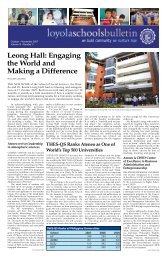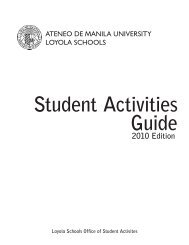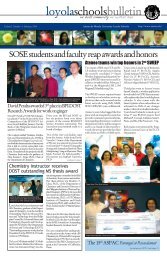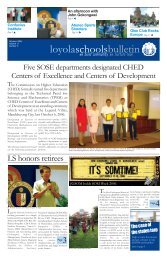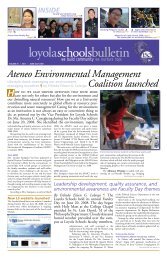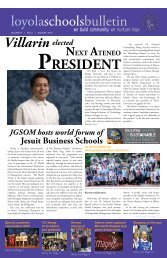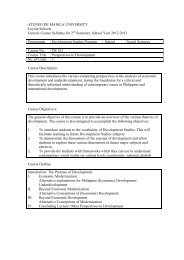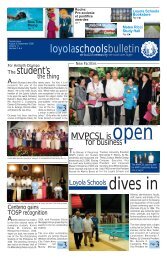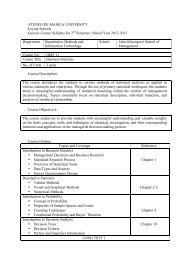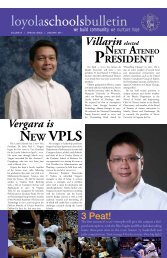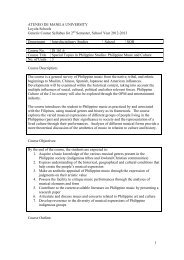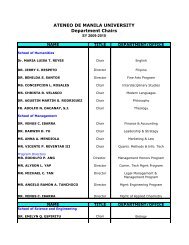Loyola schools Bulletin - Ateneo de Manila University
Loyola schools Bulletin - Ateneo de Manila University
Loyola schools Bulletin - Ateneo de Manila University
You also want an ePaper? Increase the reach of your titles
YUMPU automatically turns print PDFs into web optimized ePapers that Google loves.
loyola<strong>schools</strong>bulletin<br />
we build community we nurture hope<br />
VOLUME IV | spEcIaL IssUE | janUary 2009<br />
The Best Is Blue story on page 8<br />
<strong>Ateneo</strong> rises in world university rankings<br />
alyson yap<br />
The <strong>Ateneo</strong> <strong>de</strong> <strong>Manila</strong> <strong>University</strong>’s ranking in The Times<br />
Higher Education-qs (thes-qs) World <strong>University</strong> Rankings<br />
2008 rose this year to 254, a 197-point jump from its 2007 ranking<br />
of 451. With an overall score of 48.0 out of 100 (up from<br />
30.8 in 2007), the <strong>Ateneo</strong> tied with the Universidad Autonoma<br />
<strong>de</strong> Madrid (Spain).<br />
The <strong>Ateneo</strong> was also ranked 79th among the<br />
top 100 Arts and Humanities institutions in the<br />
world, and placed 76th among the 100 institutions<br />
with the highest employer review scores, in<br />
a tie with the <strong>University</strong> of Western Australia.<br />
How other RP universities fared<br />
Other Philippine universities which figured in the<br />
rankings were the <strong>University</strong> of the Philippines<br />
(UP), De La Salle <strong>University</strong> (DLSU), and<br />
the <strong>University</strong> of Santo Tomas (UST). UP was<br />
ranked 276, up from 398 in 2007, tying with<br />
with Universitat Ulm (Germany), Universitat<br />
Wurzburg (Germany), and Virginia Polytechnic<br />
Institute (United States). DLSU and UST were<br />
part of the group ranked 401 to 500.<br />
UP was among the top 100 Arts and Humanities<br />
institutions as well, placing 82nd and tying with<br />
INSIDE<br />
An invitation to join a tradition<br />
and a community page 2 t<br />
“rankings are important as a measure of how the world sees us, but<br />
we must reflect on them within our own view of our vision and mission.” — Nebres<br />
the <strong>University</strong> of Notre Dame (United States). UP<br />
and DLSU were also ranked among the 100 institutions<br />
with the highest employer review scores.<br />
American and British universities continued to<br />
dominate the rankings, with Harvard <strong>University</strong><br />
(United States) retaining its top spot. Among<br />
Asian universities, the <strong>University</strong> of Tokyo (Japan)<br />
ranked highest at number 19. The National<br />
<strong>University</strong> of Singapore topped other Southeast<br />
Asian universities at number 30.<br />
The THES-QS World <strong>University</strong> Rankings<br />
are based on data gathered in six categories:<br />
peer aca<strong>de</strong>mic review, recruiter review, international<br />
faculty ratio, international stu<strong>de</strong>nt ratio,<br />
stu<strong>de</strong>nt-faculty ratio, and research citations per<br />
faculty. Now in its fifth year, the rankings are<br />
conducted by QS Quacquarelli Symonds, with<br />
data gathered from 6,354 aca<strong>de</strong>mics and 2,339<br />
employers from around the world. The overall<br />
t<br />
t<br />
The four <strong>Loyola</strong> Schools<br />
put their best feet forward pages 4–5 t<br />
rankings and information on the rating system may be found at<br />
.<br />
<strong>Ateneo</strong>’s true worth and work<br />
This year’s significant climb is an indicator of the continually improving<br />
perception of the <strong>Ateneo</strong> in the highly competitive and<br />
variable international arena, and presents opportunities for the<br />
<strong>University</strong> to attract stu<strong>de</strong>nts and collaborators from different universities<br />
worldwi<strong>de</strong>. It is from an international perspective then,<br />
that the rankings are important.<br />
From the point of view of the <strong>Ateneo</strong>’s true work and worth<br />
as a Jesuit, Filipino university, the rankings count for <strong>de</strong>ci<strong>de</strong>dly<br />
less. In early 2007, <strong>University</strong> Presi<strong>de</strong>nt Fr. Bienvenido F. Nebres,<br />
SJ, summed up the correct attitu<strong>de</strong> toward surveys such as these:<br />
“Rankings in the Times survey are important because they measure<br />
how the world perceives us. But just as a person has to take<br />
what people think of them in the context of their own values and<br />
priorities, we, too, have to reflect on these perceptions and measures<br />
within our own view of our vision and mission. Thus . . . we<br />
need to do this in a way that does not move us away from our vision/mission<br />
and our traditional strengths: lea<strong>de</strong>rship formation<br />
and contribution to national <strong>de</strong>velopment. These have to continue<br />
to be our priorities as a Jesuit university committed to the<br />
service of faith and the promotion of justice and as a university in<br />
a Philippines, whose greatest challenge is overcoming poverty and<br />
national <strong>de</strong>velopment.” Joanna Ruiz<br />
An ambitious scholarship program takes wing page 3<br />
An overview of stu<strong>de</strong>nt organizations you can join pages 6–7<br />
A gui<strong>de</strong> to finding a place to stay<br />
while you study page 6 t
2<br />
L O y O L a s c H O O L s B U L L E T I n<br />
messages<br />
a message from the university presi<strong>de</strong>nt<br />
a message from the vice presi<strong>de</strong>nt for the loyola <strong>schools</strong><br />
You have the privilege of joining our community and our life at an exciting Congratulations on your accep-<br />
time, as we remember and celebrate a distinguished history which you will tance to the <strong>Loyola</strong> Schools of<br />
share with national heroes and lea<strong>de</strong>rs Jose Rizal, Gregorio <strong>de</strong>l Pilar, Claro the <strong>Ateneo</strong> <strong>de</strong> <strong>Manila</strong> <strong>University</strong>!<br />
Recto, Raul Manglapus, and Horacio <strong>de</strong> la Costa. It is our sesquicentennial, Your batch is a very special one<br />
the 150th anniversary of the <strong>Ateneo</strong> <strong>de</strong> <strong>Manila</strong> on December 10, 2009, when because you will be starting your<br />
you will be in your first year of college.<br />
<strong>Ateneo</strong> journey as we celebrate<br />
Our remembering and celebration focuses on three themes that <strong>de</strong>fine our 150th year.<br />
<strong>Ateneo</strong> history and culture: celebrating excellence, <strong>de</strong>epening spirituality, and The <strong>Ateneo</strong> <strong>de</strong> <strong>Manila</strong>, which<br />
building the nation. The themes are pegged to lines from our alma mater song, has produced heroes, lea<strong>de</strong>rs,<br />
a song which will soon be your own: “We stand on a hill,” celebrating excellence experts, movers, and pioneers,<br />
(2007–2008); “Between the earth and sky,” <strong>de</strong>epening spirituality (2008– continues to be committed to a<br />
2009); and “Down<br />
Invitation<br />
tradition of excellence and service, now re<strong>de</strong>fined in the context of global com-<br />
from the hill,”<br />
petitiveness, Filipino and Asian perspectives, and transformative lea<strong>de</strong>rship.<br />
building the nation<br />
B e c a u s e<br />
to a tradition<br />
(2009–2010).<br />
we want you<br />
Yes, an invitation to <strong>Ateneo</strong> is an invitation<br />
to be lea<strong>de</strong>rs<br />
to a tradition of excellence. We will help you<br />
and a<br />
of the future,<br />
discover your gifts and give you the opportunity<br />
we will provi<strong>de</strong> a learning envi-<br />
to be the best that you can be in<br />
community<br />
ronment that will <strong>de</strong>velop your<br />
them: in theater, arts,<br />
competencies and global vision.<br />
<strong>de</strong>bate, computing, sports, in<br />
Teachers here will challenge you;<br />
the humanities, social sciences,<br />
top-caliber classmates will en-<br />
management and entrepreneurship, science and engineering. For it is our <strong>de</strong>epgage you. You will have access to world-class facilities such as the Rizal Library,<br />
est belief, coming from St. Ignatius and the first Jesuits, that the best way we can laboratories, Internet service, sports facilities, studios, and audio-visual rooms.<br />
help you prepare for the future is by <strong>de</strong>veloping your God-given gifts. You will have opportunities to do research, write poems and fiction, practice<br />
An invitation to <strong>Ateneo</strong> is an invitation to a tradition of excellence.<br />
your skills in a real setting, or run your own business. You<br />
might even study for a term in one of more than forty part-<br />
An invitation to <strong>Ateneo</strong> is also an invitation to a community. I have been ner <strong>schools</strong> in any of sixteen countries, should you take part in the Juniormeeting<br />
with <strong>Ateneo</strong> alumni, and it is won<strong>de</strong>rful to see their friendship and Term-Abroad or stu<strong>de</strong>nt exchange programs.<br />
camara<strong>de</strong>rie and the warm memories they have of campus life. They are friends Because we want you to be agents of change, we will make you more aware<br />
who continue to be there for each other. At<br />
the <strong>Ateneo</strong> we not only help you become the<br />
best that you can be in your chosen field; we<br />
Because we want you to be lea<strong>de</strong>rs of the future, we will provi<strong>de</strong> a learning<br />
environment that will <strong>de</strong>velop your competencies and global vision.<br />
also give you lifelong friends and a community and campus you can always of Filipino and Asian perspectives, to help contextualize the global mindset<br />
come home to.<br />
and the pursuit of excellence. Our Integrated Non-Aca<strong>de</strong>mic Formation<br />
The <strong>Ateneo</strong> is also a community that seeks, like the first Jesuits who found- Program will give you a chance to experience different worlds and reflect<br />
ed our school tradition, to be “friends in the Lord.” In seeking to <strong>de</strong>epen on them. You can be part of stu<strong>de</strong>nt activities, such as the Sanggunian (the<br />
spirituality, we want to help you find a<br />
purpose in life and make a difference,<br />
so you will discover your truest self, the<br />
person God wants you to be.<br />
Finally, the <strong>Ateneo</strong> is a community<br />
that exists not just for itself but for others.<br />
We not only educate you for excellence<br />
and success but also offer you<br />
the <strong>Ateneo</strong> is a community<br />
that exists not just for itself but<br />
for others. We not only educate<br />
you for excellence and success<br />
but also offer you many opportunities<br />
to make a difference<br />
in the lives of others.<br />
LS Stu<strong>de</strong>nt Council), the<br />
Council of Organizations of<br />
the <strong>Ateneo</strong> (COA) and its 47<br />
accredited organizations, and<br />
several varsity teams.<br />
Because we want you to be<br />
persons of faith, we provi<strong>de</strong><br />
opportunities to help you<br />
many opportunities to make a differ- find your spiritual anchors through prayer, retreats, recollections, and comence<br />
in the lives of others. Together with munity celebrations of the Eucharist.<br />
a century and a half of Ateneans, you We invite you to be part of this community inspired by St. Ignatius of<br />
will discover that it is in making a difference for others that you will find your <strong>Loyola</strong>. Share with us this special year as we celebrate excellence, <strong>de</strong>epen spiri-<br />
<strong>de</strong>epest fulfillment and happiness.<br />
tuality, and build the nation—the <strong>Ateneo</strong> way.<br />
Welcome once more to the <strong>Ateneo</strong>. May<br />
the Lord give you all grace and blessings.<br />
Welcome to the <strong>Ateneo</strong> <strong>de</strong> <strong>Manila</strong> <strong>University</strong>!<br />
Bienvenido F. Nebres, SJ<br />
PreSi<strong>de</strong>Nt<br />
Maria Assunta C. Cuyegkeng, Phd<br />
ViCe PreSi<strong>de</strong>Nt For the LoyoLA SChooLS<br />
loyola<strong>schools</strong>bulletin<br />
office of the Vice presi<strong>de</strong>nt for the loyola <strong>schools</strong> Editor Joanna Ruiz art and layout Exie abola contributing writers Gary C. Devilles, Erlinda Eileen<br />
G. lolarga, Rick olivares, Joanna Ruiz photos Mitzie Correa, nono Felipe, Glenn <strong>de</strong> leon, Rick olivares, Joanna Ruiz, alyson yap <strong>Loyola</strong> <strong>schools</strong> <strong>Bulletin</strong> © 2008<br />
is published bimonthly by the office of Research and publications, 2F Gonzaga Hall, loyola <strong>schools</strong>, ateneo <strong>de</strong> <strong>Manila</strong> <strong>University</strong>, Katipunan avenue, loyola Heights,<br />
Quezon City Telephone (632) 4266001 ext 5002 Fax (632) 4266096 Mailing address p.o. Box 154, <strong>Manila</strong> 0917, philippines Email <br />
Web contributions If you would like to contribute stories and photographs to, write for, or have any story i<strong>de</strong>as for the loyola <strong>schools</strong> <strong>Bulletin</strong>,<br />
please get in touch with Joanna Ruiz at or (632)4266001 ext 5002.
V O L U M E I V s p E c I a L E d I T I O n j a n U a r y 2 0 0 9 3<br />
scholarships<br />
SeSquiceNteNNial ScholarShipS for the ateNeo<br />
By erlinda eileen G. lolarga As the <strong>Ateneo</strong><br />
moves toward its 150th year, or sesquicentennial,<br />
on December 10, 2009, themes have been coined<br />
to gui<strong>de</strong> the <strong>Ateneo</strong> community’s activities during<br />
the three years leading up to the anniversary. These<br />
are based on the <strong>Ateneo</strong>’s mission to produce lea<strong>de</strong>rs<br />
with values—men and women for others: celebrating<br />
excellence (2007: “We stand on a hill”),<br />
<strong>de</strong>epening spirituality (2008: “Between the earth<br />
and sky”), and building the nation (2009: “Down<br />
from the hill”).<br />
In line with the <strong>Ateneo</strong>’s continuing and compelling<br />
direction to attract the best and the brightest,<br />
the 500@150 Sesquicentennial Scholarship<br />
Campaign has set its sights on 500 new scholarships<br />
for the <strong>Loyola</strong> Schools. The project is animated<br />
by the i<strong>de</strong>a that the best way to make a difference<br />
is to invest in scholarships for future lea<strong>de</strong>rs.<br />
The campaign aims to raise the present crop<br />
of scholars from 1,088 to 1,600 (or from 14% to<br />
an ambitious 20%) out of a stu<strong>de</strong>nt population<br />
of about 8,000. That would make one in five stu<strong>de</strong>nts<br />
a scholar in the near future.<br />
The campaign involves the collaborative efforts<br />
of all sectors and levels of the <strong>Ateneo</strong>, from<br />
the Board of Trustees to the basic<br />
operating units and offices.<br />
The 500@150 team has begun<br />
to spread the word about how<br />
much these scholarships are<br />
nee<strong>de</strong>d and are reaching out to<br />
alumni within and outsi<strong>de</strong> the<br />
Philippines.<br />
The scholarship program<br />
through the years<br />
Data gathered by the Office of Admission<br />
and Aid (OAA) and the Office of <strong>University</strong><br />
Development and Alumni Relations (OUDAR)<br />
shows that, through the years, the percentage of<br />
scholars has kept up with the continually growing<br />
rate of enrollment. In the 1960s and 1970s,<br />
8.5% of all college stu<strong>de</strong>nts were scholars. In the<br />
1980s and 1990s, this figure rose to 13.6%. In recent<br />
years the percentage has fluctuated between<br />
12% and 14%. In 1963, there were 69 scholars<br />
out of 887 stu<strong>de</strong>nts. From 1963 to 2007, a total<br />
of 4,700 scholars graduated from the <strong>Ateneo</strong> college.<br />
At present, there are 1,088 scholars out of<br />
7,963 stu<strong>de</strong>nts.<br />
Of donations and scholarship grants<br />
The OAA lists two main types of donations to<br />
scholarships: (1) the endowment/fun<strong>de</strong>d scholarship,<br />
where the principal donation is invested and<br />
kept intact, with the income from interest supporting<br />
the scholarship; and (2) annual grants/<br />
scholarship awards, which involve a four-year tuition<br />
scholarship and pooled funds for collaterals<br />
such as dormitory fees, books, and food.<br />
Scholarship grants available to college stu<strong>de</strong>nts<br />
fall un<strong>de</strong>r four categories: (1) <strong>Ateneo</strong> Freshman<br />
Merit scholarships, (2) San Ignacio <strong>de</strong> <strong>Loyola</strong><br />
Merit scholarships for high <strong>schools</strong>, (3) aca<strong>de</strong>mic<br />
scholarships, and (4) athletic scholarships. The<br />
<strong>Loyola</strong> Schools allocates 16% of tuition income<br />
each year to scholarships, which supports around<br />
850 beneficiaries, while funds from alumni and<br />
other benefactors support around 250 more.<br />
How does one qualify for a financial grant?<br />
Stu<strong>de</strong>nts who apply for financial assistance are<br />
screened by a scholarship committee on the basis<br />
of the following criteria: (1) intellectual capability<br />
and excellent achievement (based on ACET<br />
scores, high school aca<strong>de</strong>mic performance, and<br />
the applicant’s extracurricular record); (2) financial<br />
need; and (3) <strong>de</strong>monstrated commitment to<br />
the service of the community and potential for<br />
greater service in the future.<br />
The profile of a scholar<br />
What is a typical scholar like? The data gathered<br />
Animated by the i<strong>de</strong>a that the best way to make a difference is to invest in<br />
scholarships for future lea<strong>de</strong>rs, the 500@150 Sesquicentennial Scholarship<br />
Campaign has set its sights on 500 new scholarships for the <strong>Loyola</strong> Schools.<br />
the campaign aims to raise the present crop of scholars from 1,088 to 1,600<br />
(or from 14% to an ambitious 20%) out of a stu<strong>de</strong>nt population of about<br />
8,000. that would make one in five stu<strong>de</strong>nts a scholar in the near future.<br />
by the OAA reveals that the typical <strong>Ateneo</strong> college<br />
scholar is a financial-aid awar<strong>de</strong>e, a full-tuition<br />
fee beneficiary, Metro-<strong>Manila</strong> based, and likely to<br />
have come from a private or science high school.<br />
The number of scholars is evenly spread among<br />
year levels at around 250–270 scholars each, with<br />
many taking up science or engineering courses.<br />
Many scholars strive to do well in their respective<br />
fields after graduation and some come back<br />
to teach and work in the university. Others opt to<br />
pay it forward in a different way, by supporting<br />
other scholars or contributing to university projects<br />
such as the construction of new buildings and<br />
the improvement of facilities.<br />
Fostering a tradition of giving<br />
To encourage giving, the <strong>Ateneo</strong> regularly connects<br />
with more than 45,000 local and offshore<br />
alumni based in the ASEAN region (Hong<br />
Kong, Jakarta, and Singapore) and in the United<br />
States. <strong>Ateneo</strong> connections are also strong in<br />
corporations with lea<strong>de</strong>rship and staff who are<br />
alumni, such as PLDT, HSBC, BDO, HP, Globe<br />
Telecom, IBM, ABS-CBN, and GMA-7. Ties<br />
with institutional donors (multinational corporations<br />
and foreign foundations) are strong as<br />
well. As a way of keeping in touch with alumni,<br />
the university website is continually<br />
updated to inform viewers of current<br />
events and concerns.<br />
As a way of staying connected, alumni are also<br />
encouraged to participate in outreach projects,<br />
seminars, workshops, alumni gatherings, and retreats.<br />
For the <strong>Ateneo</strong>, the time and energy spent<br />
to stay in touch with alumni is a worthwhile investment.<br />
It has been shown that alumni who give<br />
back to the university do so because of affective ties<br />
with people—mentors, classmates, dorm mates,<br />
org mates—who touched their lives in school and<br />
with whom they shared memorable times.<br />
OUDAR Director for Development Arturo<br />
Valencia says that some alumni are already helping<br />
the 500@150 campaign in different ways. The<br />
group Artists for <strong>Ateneo</strong> was formed by Twinky<br />
Lagdameo (BS LM ’92), who is in the music and<br />
media marketing field. Members inclu<strong>de</strong> Jose<br />
building a T E n E a n<br />
THe is<br />
building<br />
T H e<br />
natIon<br />
Mari Chan, the Apo Hiking Society, Karylle, Rico<br />
Blanco, Chito Miranda, and Raul Sunico. More<br />
are set to come aboard for various projects incorporating<br />
music—<strong>Ateneo</strong> Radio, <strong>Ateneo</strong> Internet<br />
Radio, GK <strong>Ateneo</strong> Music Village, and a music<br />
festival, among others. Behind the scenes, adman<br />
Sarge Lacuesta (HS ’88) is helping fire up the<br />
campaign’s advertising push.<br />
The challenge of building nation buil<strong>de</strong>rs<br />
As it approaches its 150th year, the <strong>Ateneo</strong><br />
challenges individuals and groups to help the<br />
university build nation buil<strong>de</strong>rs. For more<br />
information on the 500@150 Sesquicentennial<br />
Scholarship Campaign, please visit . Information on the <strong>Ateneo</strong><br />
Scholarship Program can be found at www.ateneo.<br />
edu>admissions>scholarships.<br />
Note: The author was herself an ASF scholar from<br />
1979–1982 un<strong>de</strong>r the Department of Psychology’s<br />
MA Social Psychology Program.
RanI JalanDonI / QUEEna lEE-CHUa<br />
4<br />
Fr. Bienvenido F. Nebres, SJ, university presi<strong>de</strong>nt,<br />
and Dr. Queena N. Lee-Chua, full professor<br />
at the Mathematics Department, were recognized<br />
as two of the 50 Men and Women of Science<br />
by the Department of Science and Technology<br />
(DOST). The recognition was ma<strong>de</strong> in honor of<br />
the DOST’s 50th anniversary in June 2008.<br />
According to DOST Secretary Estrella F.<br />
Balbastro, “our activities and festivities pay homage<br />
to the nation’s outstanding achievements and<br />
breakthroughs in science and technology over the<br />
last 50 years. We believe that the work of scientists,<br />
researchers, and other stakehol<strong>de</strong>rs must be<br />
recognized and given the opportunity to flourish,<br />
as it is the precursor to new knowledge as well as<br />
improved products, and processes vital for national<br />
<strong>de</strong>velopment.” Excerpts from Fr. Nebres’s and<br />
Dr. Lee-Chua’s citations from the DOST:<br />
Fr. Bienvenido F. Nebres, SJ (Education<br />
Icon): “Fr. Nebres has successfully reconciled the<br />
By Gary c. Devilles This year’s celebration of<br />
Buwan ng mga Wika at Kultura focused on the<br />
musicality of Filipinos. Music, after all, is seen<br />
not only as a form of entertainment but, as critic<br />
Simon Firth puts it, an expression of collective<br />
will and i<strong>de</strong>ntity.<br />
The celebration commenced with a flag-raising<br />
ceremony and an exhibit honoring the contribution<br />
of Mabuhay Singers in the field of music<br />
and commemorating their 50th anniversary.<br />
The still-active Mabuhay Singers, with Carmen<br />
Camacho, Cely Bautista, and Raye Lucero as lead<br />
singers, regaled Ateneans with their rendition of<br />
“Aawitan Kita,” “Kalesa,” “Pandangguhan,” and<br />
fields of science and religion with his work, especially<br />
in the <strong>de</strong>velopment of mathematics and science<br />
in the Philippines and in Southeast Asia.<br />
“After finishing his MS and PhD in mathematics<br />
at Stanford <strong>University</strong> in California, he foun<strong>de</strong>d<br />
the Mathematical Society of the Philippines. He is<br />
also one of the founding officers of the Southeast<br />
Asian Mathematics Society. He pioneered a consortium<br />
of leading universities in <strong>Manila</strong> to <strong>de</strong>velop<br />
PhD programs in mathematics, physics, and<br />
chemistry. This led to the <strong>de</strong>velopment of a critical<br />
mass of scientists in these areas.<br />
“Fr. Nebres chaired the Engineering and<br />
Science Education Project of the DOST and directed<br />
a team for the Department of Education on<br />
the <strong>de</strong>velopment of education<br />
plans to strengthen elementary<br />
and secondary education in the<br />
country’s poorest provinces.”<br />
Queena N. Lee-Chua<br />
(Outstanding Science<br />
Communicator): “In this millennium,<br />
science literacy is paramount<br />
to remain competitive in<br />
the global arena. All channels of<br />
creative and interesting science<br />
communication need to be harnessed<br />
for Filipinos to achieve<br />
technological un<strong>de</strong>rstanding<br />
and appreciation.”<br />
“Lulubog, Lilitaw” during the ceremony. In his<br />
introduction and opening speech, resi<strong>de</strong>nt poet<br />
Michael Coroza of the Filipino Department talked<br />
of growing up with the music of the Mabuhay<br />
Singers and how this experience shaped and influence<br />
his craft. Raye Lucero accepted the plaque of<br />
appreciation from Dr. Ma. Assunta C. Cuyegkeng,<br />
vice presi<strong>de</strong>nt for the <strong>Loyola</strong> Schools, expressing<br />
how she and her fellow Mabuhay Singers were<br />
overwhelmed and grateful by the recognition.<br />
Also, the Filipino Department together with the<br />
Humanities Organization invited Tribu Rappers and<br />
poets Mike Coroza, Vim Na<strong>de</strong>ra, and Teo Antonio<br />
to <strong>de</strong>light stu<strong>de</strong>nts with their Raplagtasan (coined<br />
from rap music and Balagtasan, a<br />
traditional verbal joust).<br />
The Buwan ng mga Wika at<br />
Kultura would not be complete<br />
without the yearly Sagala ng mga<br />
Sikat, a para<strong>de</strong> of characters in literature<br />
and popular culture. Stu<strong>de</strong>nts<br />
of different Filipino classes donned<br />
costumes and <strong>de</strong>corated floats for<br />
this grand activity.<br />
The Filipino Department<br />
capped the celebration with the KA<br />
poetry jamming and awarding ceremony.<br />
In its tenth year, the poetry<br />
jamming was aptly named KA-PU,<br />
kapu being the Kapampangan word<br />
for “ten.” The highlight of KA was<br />
the music competition, with Gino<br />
Afable taking the top prize with<br />
his original composition “Hindi<br />
Madali,” followed by Kenneth<br />
Abante with “Ikaw Pa Rin,” and<br />
L O y O L a s c H O O L s B U L L E T I n<br />
the loyola <strong>schools</strong><br />
Nebres and Lee-Chua among<br />
50 men and Women of science<br />
Bienvenido F. Nebres, SJ and Queena N. Lee-Chua<br />
BuwaN NG wika<br />
Filipino Department celebrates<br />
Filipino musicality<br />
A float from the ‘Sagala ng mga Sikat’<br />
“the work of scientists, researchers, and other stakehol<strong>de</strong>rs<br />
must be recognized and given the opportunity<br />
to flourish.” — doSt Secretary estrella F. Balbastro<br />
Lee-Chua, in her own words, best <strong>de</strong>scribes her passion to share<br />
and spread the value of un<strong>de</strong>rstanding science both insi<strong>de</strong> and outsi<strong>de</strong><br />
the lecture hall. Numerous books, articles, lectures, columns,<br />
and other communication tools in her name mirror a vastly creative<br />
and disciplined persona. She has written science and math books,<br />
a newspaper column, and teachers both subjects to stu<strong>de</strong>nts, par-<br />
ents, media, and practically everybody<br />
else. But she remains<br />
consistent in her goal to make<br />
science and math learning “fun”<br />
through “simpler, more un<strong>de</strong>rstandable<br />
language.” She brings the “fun” to print, radio, TV, online,<br />
and interpersonal audiences.<br />
sose s c H O O l<br />
O F s c i e n c e<br />
And engineeRing<br />
the School of Science and engineering envisions a Philippine society in<br />
harmony with nature, where the fruits of science and engineering are<br />
used in the service of God, country, and all its people. Aiming to provi<strong>de</strong><br />
excellent training for stu<strong>de</strong>nts in basic and applied disciplines, we seek to<br />
train highly qualified and socially responsible scientists and engineers who<br />
will become lea<strong>de</strong>rs in industry, aca<strong>de</strong>me, and other sectors of society. We<br />
seek to build our strength both in individual <strong>de</strong>partments and through<br />
active interdisciplinary un<strong>de</strong>rtakings, where the greatest progress is likely<br />
to occur, as well as to meet the challenges of globalization, sustainability,<br />
poverty, and the environment. We commit to providing relevant and<br />
responsible scientific and technical expertise nee<strong>de</strong>d by the country<br />
as well as to <strong>de</strong>veloping science and engineering that empowers the<br />
un<strong>de</strong>rprivileged in society.<br />
soh scHOOl OF<br />
HumAniTies<br />
the School of humanities aims to provi<strong>de</strong> stu<strong>de</strong>nts with a liberal<br />
humanistic education distinguished by sapientia et eloquentia. this liberal<br />
humanistic education draws from the rich traditions of philosophy, faith,<br />
literature, language, art, and culture. it is manifested through courses<br />
<strong>de</strong>signed for the holistic formation of stu<strong>de</strong>nts who are articulate and<br />
critical, imaginative and productive, stu<strong>de</strong>nts who are rooted in their own<br />
culture, yet open to other cultures, proactive in the global environment,<br />
and strongly committed to faith and justice.<br />
Richard Camacho with his “Araw at Buwan.”<br />
In<strong>de</strong>ed, this year’s Buwan ng Wika celebration<br />
proved once again how dynamic music is, and<br />
how, in the <strong>Ateneo</strong>, it paves the way for expressing<br />
i<strong>de</strong>ntity and culture.<br />
the Mabuhay<br />
Singers
V O L U M E I V s p E c I a L E d I T I O n j a n U a r y 2 0 0 9 5<br />
JGSoM StuDeNt eNterpriSe ceNter<br />
A world of<br />
experience<br />
is a recipe for success<br />
By rick olivares “I can’t cook,” unabashedly admits Camille Co<br />
(IV BS MGT). “But I love to eat. Putting up Fiesta Atenista has given<br />
me a reason to try.” “I can’t cook either,” seconds Zerge Zandueta<br />
(IV BS MGT) of Noodle Nook. “Prito prito lang. But food is a topof-mind<br />
choice for a business.”<br />
The John Gokongwei School of Management (JGSOM) Stu<strong>de</strong>nt<br />
Enterprise Center (JSEC) not only puts stu<strong>de</strong>nts insi<strong>de</strong> the kitchen<br />
of food stalls but gives them a taste of the pressure cooker that is<br />
real-world entrepreneurship.<br />
This summer, Christian Mendoza (III AB IS) would wake up<br />
early on Saturday mornings, <strong>de</strong>frost food, slice vegetables, open up<br />
Kebab House at JSEC, and put on his best smile for customers. “I<br />
knew it wasn’t easy setting up your own business,” he says of his<br />
jgsom<br />
jOHn gOkOngWei<br />
scHOOl OF<br />
mAnAgemenT<br />
the John Gokongwei School of Management is a regionally recognized<br />
center of excellence and lea<strong>de</strong>rship in un<strong>de</strong>rgraduate business education.<br />
We shape our stu<strong>de</strong>nts into business lea<strong>de</strong>rs equipped to respond to the<br />
needs of tomorrow’s world: people who are global in perspective and<br />
interdisciplinary in approach, technically proficient and analytical yet<br />
humanistic and people-oriented; achievers gui<strong>de</strong>d by a strong set of core<br />
values, eager and able to provi<strong>de</strong> ethical and principle-centered lea<strong>de</strong>rship;<br />
professionals and entrepreneurs motivated by the spirit of magis or<br />
excellence, inflamed by the passion to make a difference, wherever their<br />
lives may take them. We offer innovative programs characterized by a<br />
strong liberal-arts core curriculum coupled with a business curriculum that<br />
combines the rigors of aca<strong>de</strong>mic and experiential learning, in or<strong>de</strong>r to give<br />
our stu<strong>de</strong>nts a broad perspective of the management challenge.<br />
sossscHOOl<br />
OF<br />
sOciAl sciences<br />
the School of Social Sciences works toward a society ma<strong>de</strong> more human<br />
by its commitment to teaching, research, and action. We see a world<br />
<strong>de</strong>dicated to aca<strong>de</strong>mic excellence in which humanistic values and ignatian<br />
spirituality harmonize with mo<strong>de</strong>rn technology, in which passion for justice<br />
bonds with service to the country. We seek to form a world of mature<br />
spirituality, focused on respect for the individual, freedom of scholarship,<br />
unity in collegiality, and the diversity of disciplines—thus recognizing<br />
a multiplicity of perspectives from which to examine society, its history,<br />
and its social, political, and economic lives. our pursuit of scientific study<br />
is groun<strong>de</strong>d in Philippine society and culture, from which it seeks to<br />
contribute to national <strong>de</strong>velopment and to Asia-Pacific and ultimately<br />
global intercultural heritage.<br />
They came, they saw, and they were invariably<br />
awed. So it was as more than 500 stu<strong>de</strong>nts, campus<br />
journalists, and advisers from 126 public high<br />
<strong>schools</strong> in Metro <strong>Manila</strong> were treated to a visual<br />
feast and a visual literacy training session by the<br />
Konrad A<strong>de</strong>nauer Asian Center for Journalism<br />
Photojournalism tutor ernie Sarmiento makes a point to high<br />
school stu<strong>de</strong>nt journalists<br />
initial foray into entrepreneurship, “but experiencing<br />
it first-hand while at school gives you a<br />
better appreciation for a lot of things, especially<br />
for what you don’t learn insi<strong>de</strong> the classroom.”<br />
The challenge of mo<strong>de</strong>rn education is to make<br />
classroom teachings relevant. “It [having a business<br />
at the JSEC] adds to what we learn in the<br />
classroom,” affirms Paolo Bernardo (III BS LM)<br />
of Blue Aquila, which serves Italian food. “It—to<br />
steal a line from Jerry Maguire—completes your<br />
education. So if you <strong>de</strong>ci<strong>de</strong> to pursue it after college,<br />
you know what to expect.”<br />
In or<strong>de</strong>r to help themselves better un<strong>de</strong>rstand<br />
the nature of entrepreneurship, the stu<strong>de</strong>nts have<br />
enrolled in subjects like finance and lea<strong>de</strong>rship,<br />
among others. Zandueta confirms that he and his<br />
partners Mica Cariño and Bradley Pineda also<br />
sought the guidance of their parents for their business.<br />
“After all, they should know a thing or two<br />
about work and business.”<br />
William Mallari, director of the <strong>Loyola</strong> Schools<br />
Bookstore and coordinator for stu<strong>de</strong>nt entrepreneurial<br />
initiatives, says that key learning areas for<br />
the budding entrepreneurs are human relations,<br />
forecasting, logistics, and setting priorities. “These<br />
are hardcore truths and learnings for them,” says<br />
Mallari. “These are things they have to learn as<br />
they go along.”<br />
The initial 50 proposals sent to JGSOM were<br />
pared down to 20 based on the viability of each proposal<br />
as a franchise in the stu<strong>de</strong>nt-run mall. Adds<br />
Mallari, “We look at how they intend to run their<br />
business. There are also many things to consi<strong>de</strong>r<br />
such as quality control, cleanliness, and packaging.<br />
We make it clear that they cannot serve leftovers<br />
at the <strong>Ateneo</strong> <strong>de</strong> <strong>Manila</strong> <strong>University</strong> (ACFJ) at<br />
the <strong>Manila</strong> leg of the World Press Photo 2008<br />
Exhibition in August 2008. The traveling exhibit,<br />
a collection of about 200 photos which<br />
won awards at the annual World Press Photo<br />
Competition, was a partnership project of the<br />
ACFJ and the Netherlands Embassy and supported<br />
by SM Supermalls and Unilever. The exhibit<br />
took place at three SM malls in Metro <strong>Manila</strong>.<br />
Faculty members, alumni, and stu<strong>de</strong>nts of<br />
the ACFJ photojournalism program gave lectures<br />
and conversed with the campus journalists<br />
and their teachers as they viewed the pictures.<br />
Through the gui<strong>de</strong>d tours, the<br />
ACFJ sought to help the stu<strong>de</strong>nts<br />
un<strong>de</strong>rstand and appreciate<br />
the principles, significance,<br />
and power of press photography,<br />
said Dr. Violet B. Val<strong>de</strong>z,<br />
ACFJ executive director. She<br />
explained that, with the increased<br />
accessibility of cameras<br />
and the growing participation<br />
of citizens in news production,<br />
it has become even more important<br />
these days to know how<br />
photography works.<br />
The exhibit showed works<br />
from the competition’s thematic<br />
categories, including sports,<br />
nature, and the arts. The exhibit<br />
centerpiece was a photo<br />
by British photojournalist<br />
After the gui<strong>de</strong>d tour, stu<strong>de</strong>nt<br />
journalists take their own photos<br />
the loyola <strong>schools</strong><br />
and that the health of everyone is paramount.”<br />
Currently there are 11 food stalls and one print<br />
shop at the JSEC. “That’s all we can accommodate<br />
for now, but we are <strong>de</strong>finitely looking at expansion<br />
in the future,” says Mallari. “It’s a rare<br />
opportunity for the stu<strong>de</strong>nts,” says JGSOM Dean<br />
Rodolfo Ang of this experiential lab that other<br />
<strong>schools</strong> are beginning to copy. “It builds better<br />
businessmen and it makes for a great headstart<br />
into the world.”<br />
worlD preSS photo 2008<br />
ACFJ treats campus<br />
journalists to world’s<br />
top photo show<br />
Tim Hetherington showing an American soldier<br />
resting at a bunker in Afghanistan. It was awar<strong>de</strong>d<br />
Photo of the Year in the competition, which has<br />
been run by the World Press Photo Foundation,<br />
a Dutch NGO based in Amsterdam, for more<br />
than 50 years.<br />
Many other pieces also caught the viewers’<br />
attention. Among them were a <strong>de</strong>piction of the<br />
practices of the Maria Lionza, a sect in Venezuela.<br />
Shot by the Spanish photographer Cristina<br />
Garcia Ro<strong>de</strong>ro, the photos showing the sect’s burial<br />
and cleansing rituals were awar<strong>de</strong>d the third prize<br />
in the Arts and Entertainment Stories category.<br />
Another crowd-stopper<br />
was the set of pictures<br />
showing the last<br />
moments of Pakistan’s<br />
Benazir Bhutto. Shot by<br />
John Moore of the US for<br />
Getty Images, the photos<br />
were judged first prize<br />
in the Spot News Stories<br />
category. The set inclu<strong>de</strong>d<br />
a photo of Bhutto, with<br />
her back against the camera,<br />
addressing a throng of<br />
supporters at the Liaqat<br />
Bagh Park in Rawalpindi.<br />
Also captured was a scene<br />
of Bhutto waving from<br />
the escape hatch of her armored<br />
vehicle seconds before<br />
she was assassinated.
Joanna RUIz<br />
6<br />
oN- aND off-caMpuS houSiNG for ateNeo StuDeNtS<br />
A home away from home<br />
By erlinda eileen G. lolarga Where do stu<strong>de</strong>nts,<br />
both local and international, stay when<br />
they want to live near the school environs of the<br />
<strong>Ateneo</strong> <strong>de</strong> <strong>Manila</strong> <strong>University</strong>? With a population<br />
of about 7,700 un<strong>de</strong>rgraduate stu<strong>de</strong>nts, 1,300<br />
graduate stu<strong>de</strong>nts, and a stream of visiting international<br />
stu<strong>de</strong>nts and professors, resi<strong>de</strong>ntial spaces<br />
both on- and off-campus are in high <strong>de</strong>mand.<br />
Housing options from the simple to the luxurious<br />
are wi<strong>de</strong>-ranging. Stu<strong>de</strong>nts can visit the <strong>Ateneo</strong><br />
website for a list conveniently put together by the<br />
Office of the Associate Dean for Stu<strong>de</strong>nt Affairs<br />
(ADSA) every school year. For international stu<strong>de</strong>nts,<br />
the Office of International Programs (OIP)<br />
offers not only an additional list of apartments<br />
and condominium units to choose from but also<br />
provi<strong>de</strong>s the extra service of having visiting international<br />
stu<strong>de</strong>nts accompanied by OIP staff and/<br />
or <strong>Ateneo</strong> stu<strong>de</strong>nt volunteers when they do their<br />
house-hunting upon arrival in <strong>Manila</strong>. Word-ofmouth<br />
referrals by stu<strong>de</strong>nts and friends are also a<br />
good source of information for convenient and<br />
economical places to stay, particularly in <strong>Loyola</strong><br />
Heights and Marikina.<br />
The new university dormitory<br />
On-campus accommodations for <strong>Loyola</strong> Schools<br />
stu<strong>de</strong>nts and international guests have grown<br />
tremendously since the completion of the new<br />
<strong>University</strong> Dormitory, which opened its doors<br />
to <strong>Ateneo</strong> stu<strong>de</strong>nts in May 2008. The <strong>University</strong><br />
Dormitory can accommodate 600 resi<strong>de</strong>nts and<br />
spreads out into two wings: the North Wing for<br />
male dormers and the South Wing for female<br />
dormers. For many years, the old resi<strong>de</strong>nce halls<br />
on the <strong>Loyola</strong> Heights campus have served only<br />
a small fraction of stu<strong>de</strong>nts in need of housing,<br />
with Cervini (for male dormers) and Eliazo (for<br />
female dormers) Halls able to house a combined<br />
400 resi<strong>de</strong>nts. With the new resi<strong>de</strong>nce halls<br />
now in use, there are plans to refurbish Cervini<br />
and Eliazo Halls, which, beginning schoolyear<br />
2009–2010, will house only freshmen and international<br />
guests.<br />
rooms and amenities Rooms at the new<br />
<strong>University</strong> Dormitory can accommodate four<br />
A preview<br />
of stu<strong>de</strong>nt orgs<br />
LeFt the newly inaugurated<br />
<strong>University</strong> dormitory is<br />
convenient and safe. BeLoW<br />
A view of the entrance, and<br />
insi<strong>de</strong> the dormitory’s rooms.<br />
The Council of Organizations of the <strong>Ateneo</strong><br />
(COA) invites you to take a first step towards a<br />
journey of self-discovery by joining an organization<br />
during Recruitment Week. The path to embark<br />
on is one’s own choice, but the organizations<br />
are committed to making it a meaningful and<br />
worthwhile journey. As significant as the first step<br />
is the journey itself. After joining an organization<br />
of your choice, COA encourages you to make the<br />
most of it by becoming an active member, participating<br />
in the various activities your organization<br />
has to offer.<br />
The COA is composed of 47 accredited <strong>Loyola</strong><br />
Schools stu<strong>de</strong>nt organizations and is divi<strong>de</strong>d into<br />
L O y O L a s c H O O L s B U L L E T I n<br />
dormers each. Apart from cabinets and <strong>de</strong>sks<br />
for every room occupant, all rooms are also<br />
equipped with Internet connections and local<br />
phones to facilitate communication within the<br />
dorm. Elevators service all seven levels of each<br />
building. There are common bathrooms on every<br />
floor, each built with six toilets, ten lavatory sinks,<br />
and four shower areas with hot and cold water.<br />
Rooms with windows are equipped with electric<br />
fans, while rooms which have<br />
no windows are air conditioned.<br />
Compact single rooms on every<br />
floor are earmarked for graduate<br />
stu<strong>de</strong>nts, visiting professors,<br />
or dorm mentors. These rooms<br />
are provi<strong>de</strong>d with air conditioning<br />
units and a bath and toilet.<br />
Room assignments for stu<strong>de</strong>nts<br />
are <strong>de</strong>ci<strong>de</strong>d based on a lottery<br />
system.<br />
Dorm life Japanese exchange<br />
stu<strong>de</strong>nts Nami Iwashita<br />
of Kyushu <strong>University</strong> and Yaka<br />
Ito of Nanzan <strong>University</strong> were<br />
quartered at Eliazo Hall for a semester<br />
before moving to the new<br />
<strong>University</strong> Dormitory. They are<br />
happy with the new dormitory<br />
for safety and security reasons<br />
and appreciate the presence of<br />
security guards. Practical conveniences like the<br />
microwave ovens and toasters, free drinking water,<br />
hot water for showers, and tissue in the toilets add<br />
to the convenience of staying in the dorm. The<br />
smiles and “good attitu<strong>de</strong>” of the dormitory staff<br />
are plus factors as well. After the second semester,<br />
the Katipunan area offers a<br />
variety of housing options.<br />
she and Yaka plan to try boarding<br />
houses off-campus to be more immersed<br />
in everyday Filipino life before<br />
returning to Japan.<br />
a work in progress A<br />
few weeks from the <strong>University</strong><br />
Dormitory’s formal inauguration on December<br />
6, 2008, Resi<strong>de</strong>nce Halls Director Tim Gabuna<br />
talked about further plans for the dormitories.<br />
Rafters are being constructed to protect corridors<br />
from rain. Landscaping open grounds and in-between<br />
spaces is also being planned to add to the<br />
restful atmosphere. Also being consi<strong>de</strong>red is the<br />
conversion of some dorm rooms into common<br />
rooms where resi<strong>de</strong>nts can meet and socialize. The<br />
open roof <strong>de</strong>ck and dormitory café with an al fres-<br />
nine clusters: business, faith formation, health<br />
and environment, intercultural relations, issue<br />
and policy analysis, media and the creative arts,<br />
performing arts, science and technology, and the<br />
sector-based cluster. Here is a preview:<br />
faith forMatioN cluSter The Faith<br />
Formation Cluster is <strong>de</strong>dicated to contributing to<br />
the spiritual growth and rootedness of Ateneans.<br />
The groups may have varying approaches—<br />
catechism, liturgy, worship, social action, and<br />
Ignatian spirituality—but they are bound together<br />
by the belief in God and his love for all. The<br />
cluster comes together as one community expressing<br />
their faith and contributing to the holistic <strong>de</strong>velopment<br />
of fellow Ateneans. Member organizations:<br />
ateneo catechetical instruction league<br />
(ACIL) • <strong>Ateneo</strong> Christian Life Community<br />
(ACLC) • <strong>Ateneo</strong> College Ministry Group<br />
(ACMG) • <strong>Ateneo</strong> Stu<strong>de</strong>nt Catholic Action<br />
(AtSCA) • Youth For Christ–<strong>Ateneo</strong> (YFC)<br />
stu<strong>de</strong>nt housing<br />
co dining area, both affording views of Marikina<br />
Valley, are un<strong>de</strong>rgoing finishing.<br />
Off-campus accommodations<br />
If one is looking for off-campus housing, there<br />
are many boarding houses for male and female<br />
stu<strong>de</strong>nts as well as apartment/condominium units<br />
in the <strong>Loyola</strong> Heights area. Along Katipunan<br />
Avenue, the Prince David Condominium,<br />
Burgundy Plaza, and Burgundy<br />
Place condominium buildings<br />
and the Dormitoryana<br />
complex are an obvious choice<br />
among stu<strong>de</strong>nts. Newer buildings<br />
which cater specifically to<br />
stu<strong>de</strong>nts are Elizabeth Hall, the<br />
Oracle Building, and My Place.<br />
The Varsity Hills area behind<br />
Katipunan Avenue also abounds<br />
with apartments and houses renovated<br />
into dormitories.<br />
Living in this area offers more<br />
freedom of choice for dormers<br />
as restaurants, supermarkets,<br />
drug stores, coffee shops, convenience<br />
stores, laundries, and<br />
Internet cafés are within walk-<br />
ing distance. To enter <strong>Ateneo</strong>,<br />
stu<strong>de</strong>nts either walk (about ten<br />
minutes from <strong>Loyola</strong> Heights to<br />
the school buildings) or take tricycles which are<br />
allowed to enter the school. For those who need<br />
to leave the <strong>Loyola</strong> Heights area, the Katipunan<br />
Light Rail Transit (LRT) station may be reached<br />
via tricycle or jeepney, plus a short walk. Taxi<br />
cabs are also easy to hail from any point along<br />
Katipunan or from within the campus.<br />
Another area which offers affordable lodging<br />
is Barangka village in Marikina, directly behind<br />
and below the <strong>Ateneo</strong> campus. Accommodations<br />
here may usually be found in houses which accept<br />
boar<strong>de</strong>rs. Barangka is also conveniently located, as<br />
a path from it leads directly to the school. While<br />
Katipunan offers the convenience of the <strong>Loyola</strong><br />
Heights shops, Barangka is a short distance from<br />
the Riverbanks complex, and now, SM Marikina.<br />
Either on- or off-campus, there is no shortage<br />
of safe, <strong>de</strong>cent accommodations which will fit<br />
your budget and preferences. Finding your new<br />
home away from home is not just a chore, but another<br />
step toward your new life as an Atenean.<br />
Happy house-hunting!<br />
health aND eNViroNMeNt cluSter The<br />
Health and Environment Cluster is geared toward<br />
the holistic <strong>de</strong>velopment of Filipino society<br />
through the empowerment of health and environment<br />
facets of the <strong>Ateneo</strong> community specifically<br />
through responsible mountaineering, social<br />
health, peer guidance, and logical environmentalism.<br />
Members: <strong>Loyola</strong> Mountaineers (LM) •<br />
Pre-Med Society of the <strong>Ateneo</strong> (PMSA) • <strong>Ateneo</strong><br />
environmental Science Society (eSS)<br />
iNtercultural relatioNS cluSter In<br />
today’s globalized world, connecting and collaborating<br />
with people of different cultures is key. We<br />
are now citizens of the world. The Intercultural<br />
Relations Cluster aims to provi<strong>de</strong> venues of interaction<br />
and integration among the different local<br />
cultures in the <strong>Loyola</strong> Schools and the various<br />
foreign cultures that visit each year. The cluster<br />
aspires to foster a <strong>de</strong>eper sense of un<strong>de</strong>rstanding<br />
of other cultures in its members so that they may<br />
GlEnn DE lEon
nono FElIpE<br />
V O L U M E I V s p E c I a L E d I T I O n j a n U a r y 2 0 0 9 7<br />
empower others to become global citizens. Members: ateneo lingua ars cultura<br />
(ALAC) • <strong>Ateneo</strong> Stu<strong>de</strong>nt Exchange Council (ASEC) • Celadon<br />
ISSUE AND POLICY ANALYSIS CLUSTER The Issue And Policy Analysis Cluster<br />
believes in expressing and conveying well-informed opinions and acting upon<br />
them. The organizations practice critical thinking, promote discourse, and build<br />
social awareness. Members: <strong>Ateneo</strong> Debate Society (ADS) • <strong>Ateneo</strong> Economics<br />
Association (AEA) • A-Stat Circle (A-STAT) • Enterteynment Para sa Tao, Bayan,<br />
Lansangan at Diyos (ENTABLADO) • The <strong>Ateneo</strong> Harvard Project for Asian and<br />
International Relations Union (HPAIR) • The Assembly (ASSEMBLY)<br />
MeDia aND the creatiVe artS cluSter The Media And The Creative Arts<br />
Cluster is a venue for forming lea<strong>de</strong>rs who are effective, creative, and responsible<br />
media practitioners and artists. The four organizations in the cluster impact the<br />
<strong>Ateneo</strong> community through their own respective media specializations, advocacies,<br />
and art interpretation. With distinct core competencies, each organization has its<br />
own way of shaping its members into creative and a<strong>de</strong>pt artists and communicators.<br />
Members: <strong>Ateneo</strong> Association of Communication Majors (ACOMM) • <strong>Ateneo</strong><br />
Musicians’ Pool (AMP) • Collegiate Society of Advertising (COSA) • <strong>Loyola</strong> Film<br />
circle (lfc)<br />
perforMiNG artS cluSter The Performing Arts Cluster is composed of diverse<br />
organizations that strive to make a difference through the various forms of<br />
art they advocate. They celebrate God’s gifts through each performance. The cluster<br />
hopes to open people’s eyes to the fact that art does not exist just for entertainment’s<br />
sake. It aims to instill the value of art appreciation and cultural awareness to<br />
the whole community. Fueled by immense passion, this pool of talented people will<br />
bring forth the best artists of the country. Members: ateneo Blue repertory (Blue<br />
REPERTORY) • <strong>Ateneo</strong> <strong>de</strong> <strong>Manila</strong> College Glee Club (ACGC) • The Company of<br />
<strong>Ateneo</strong> Dancers (CADS) • Tanghalang <strong>Ateneo</strong> (TA)<br />
Sector-BaSeD cluSter Isang pag-aalay ng sarili, isang pagbubukas para<br />
sa tawag ng iba, para sa iba’t-ibang nangangailangang sektor sa lipunan: pitong<br />
organisasyon na sa kabila ng magkakaibang paraan ng pagtugon ay pinagsama-sama<br />
upang paigtingin ang iisang adhikain: ang paglilingkod upang iangat at akayin ang<br />
ating mga kababayan mula sa anino ng kahirapan, kamangmangan, kapansanan, at<br />
karahasan. Mula sa paglalaan ng munting oras sa pamamagitan ng mismong pagbababad<br />
sa komunidad, sa paaralan at mga ospital: isang paghuhubog, isang paggagabay<br />
ang aming iniaalay upang sa pagtuntong ng bawat dapit-hapon ay panibagong<br />
The best is blue<br />
continued from page 8<br />
would pay the price for their overly aggressive<br />
play. Rico Maierhofer was slapped with a second<br />
technical for taunting with 1:31 left in the quarter<br />
and subsequently ejected from the game. Almost a<br />
minute later, Casio picked up his fourth foul.<br />
Despite their rival’s missing their two vital cogs,<br />
<strong>Ateneo</strong> was unable to capitalize on the Archers’<br />
misfortune as they remained scoreless for four<br />
minutes. However, with un<strong>de</strong>r six minutes to play<br />
in the fourth period, the Archers problems were<br />
compoun<strong>de</strong>d as they were already in penalty.<br />
Tiu’s three free throws off a three-point challenge<br />
at the 8:24 mark was the game’s turning<br />
point. It gave <strong>Ateneo</strong> breathing room as it pad<strong>de</strong>d<br />
the lead to 53–47, a luxury in the now-close<br />
match. That was it for the team from Taft, their<br />
offensive ineptitu<strong>de</strong> ma<strong>de</strong> worse by the <strong>de</strong>fensive<br />
noose hung on them by <strong>Ateneo</strong>. The Archers<br />
scored a low of four points in the last quarter, all<br />
League MVP rabeh Al-hussaini, who led the<br />
team with 27 points in Game 1, whoops it up.<br />
of them coming from PJ Walsham who all season<br />
long ro<strong>de</strong> Franz Pumaren’s bench.<br />
In the fourth finals matchup between the two<br />
teams in the UAAP, the <strong>Ateneo</strong> Blue Eagles repaid<br />
one final <strong>de</strong>bt as they beat the De La Salle Green<br />
Archers 62–51 for their fourth UAAP title and<br />
eighteenth overall (including the fourteen in the<br />
NCAA). It was <strong>Ateneo</strong>’s fourth championship victory<br />
in six meetings with La Salle as well.<br />
The Blue Eagles showed everyone that they too<br />
can come back.<br />
In 2006, JC Intal joined a slam dunk contest<br />
and wore Norman Black’s San Miguel jersey<br />
during one of his attempts. This year, the Blue<br />
Eagles paid tribute to the man who led them all<br />
these years by taking to the court of the Araneta<br />
Coliseum before Game One wearing a black shirt<br />
with the number 24 emblazoned on the back.<br />
When the oncourt celebration began, Al-<br />
Hussaini and Black enjoyed a tearful embrace in<br />
center court. “Thank you,” said the coach to his<br />
center who enjoyed one of the finest seasons of<br />
any <strong>Ateneo</strong> player ever. “Hindi, coach,” replied<br />
Al-Hussaini. “Thank you po sa inyo.”<br />
A cast of former Blue Eagles littered the court.<br />
There was Eric Reyes (1987 and ’88 champions)<br />
who congratulated his old teammate Gene Afable<br />
for a job well done. There were Intal and Macky<br />
Escalona (of the 2002 champion team) who both<br />
said prior to the game that they wouldn’t miss this<br />
for the world. “Bawi na para sa amin,” beamed<br />
Escalona. Bajjie Del Rosario and Magnum<br />
Membrere of the 2002 team were also in smiles<br />
as they congratulated their former teammates.<br />
Ricky Palou, who was a long time ago his team’s<br />
(1969 NCAA champions) version of Nonoy<br />
Baclao, shook hands with his successor. “Good<br />
job,” said “Palpal” Palou (as he was fondly nicknamed<br />
all those years ago by the sports press) as he<br />
shook hands with the Finals MVP who had a net<br />
dangled around his neck. Then they shared a high<br />
five. There was Nonoy Chuatico (1987 champions)<br />
who played for Robert Jaworski’s Ginebra<br />
San Miguel teams of the early 1990’s, who also<br />
wore an iamnonoy shirt. “Makikisawsaw ako,” he<br />
laughed. “Sarap maging champion ulit.”<br />
There was Sandy Arespacochaga who waxed eloquent<br />
one final time. During the bonfire party of<br />
2002, he walked around Bellarmine Field clutch-<br />
stu<strong>de</strong>nt organizations<br />
pag hihilom ng sugat na dulot ng kawalan at kakulangan ang aming maipa abot;<br />
isang pagpupumilit na magdulot ng mumunting kagalakan, manghimok ng mga<br />
musmos na mga panaginip at mga payak na ngiti; mga pinagtagpi-tagping ngiting<br />
nag papa igting sa pagnanasa ng bawat isa na maging katuwang sa pagkamit sa mas<br />
maayos at mas hustong pamumuhay sa iba’t ibang sektor ng lipunan sa bansa. Mga<br />
kasapi: Gabay • Kaingin • Kythe–<strong>Ateneo</strong> • Musmos • <strong>Ateneo</strong> Special Education<br />
Society (SPEED) • Tugon • <strong>Ateneo</strong> Stu<strong>de</strong>nt Trainers (STRAINS)<br />
SCIENCE AND TECHNOLOGY CLUSTER The Science And Technology Cluster<br />
invites you to imagine a world of boundless opportunity, exploring new frontiers<br />
while seeking the inner <strong>de</strong>pths of the mind. Imagine a world where robots roam<br />
the fields, gadgets are at your fingertips, and cyberspace is your playground. This<br />
is the world of the open mind, where persons see the ordinary and make it extraordinary.<br />
And this is just the beginning. Members: ateneo chemical Society<br />
(ACHES) • <strong>Ateneo</strong> Electronics Engineering Society (AECES) • <strong>Ateneo</strong> Mathematics<br />
Society (AMS) • <strong>Ateneo</strong> Biological Organization (BOX) • Computer Society<br />
of the <strong>Ateneo</strong> (COMPSAT) • The League of Physicists (LEAPS) • Management<br />
Information Systems Association (MISA) • <strong>Ateneo</strong> Psyche<br />
BuSiNeSS cluSter The Business Cluster is composed of seven business organizations,<br />
each equipped with their unique core competencies. The Cluster strengthens<br />
and shares these competencies in or<strong>de</strong>r to achieve excellence that we can impart<br />
to the <strong>Ateneo</strong> community and beyond. We form people who will do good business.<br />
We <strong>de</strong>velop ethical, altruistic, and caring future business lea<strong>de</strong>rs who believe<br />
that the bottom line is not all about how many zeroes you have but how many lives<br />
you’ve touched. In the spirit of nation-building, we are united in sharing our unique<br />
skills—creative expression, foreign relations, marketing, entrepreneurship, legal, operations<br />
research, and investing to those insi<strong>de</strong> and outsi<strong>de</strong> the <strong>Ateneo</strong>. We will equip<br />
them with quality business knowledge, as well as provi<strong>de</strong> them with the skills to<br />
start and manage their own. Members: ateneo association of communications<br />
Technology Management (ACTM) • Association Internationale <strong>de</strong>s Étudiants<br />
en Sciences Économiques et Commerciales (AIESEC) • <strong>Ateneo</strong> Junior Marketing<br />
Association (AJMA) • <strong>Ateneo</strong> Lex (A Lex) • <strong>Ateneo</strong> Management Associaion<br />
(AMA) • Management Engineering Association (MEA) • Management Economics<br />
Organization (MECO)<br />
For more information about each organization, please visit the COA website at<br />
.<br />
Co-captain Chris tiu finished Game 2 with a<br />
team-high 16 points.<br />
ing the trophy that elu<strong>de</strong>d him as a player. “This<br />
is a good win,” he grinned as he allowed himself<br />
a smile that is elusive when he has his game face<br />
on. There was Jimmy Alabanza, who in retirement<br />
spends all his waking hours trying to help<br />
his alma mater, shaking hands with every one,<br />
even with people he didn’t know.<br />
And there was Arao wearing a Mike Baldos jersey<br />
with Yuri Escueta’s number taped in front. His<br />
large frame standing out in the sea of blue that had<br />
crow<strong>de</strong>d the maple court, he smiled that big goofy<br />
smile of his and sought out his former teammates.<br />
He found his buddies Escueta, and Baldos and the<br />
three huddled up. They emerged with tears in their<br />
eyes as Escueta tapped Arao’s chest as if to say, “Para<br />
sa ’yo ’to, Ford.” The big man wiped his eyes and<br />
flashed that grin of his. “Para sa community ’to.”<br />
It en<strong>de</strong>d right where it began: in the solemn<br />
refuge of the Church of the Gèsu. And win or<br />
lose, as always, every one was there to give thanks,<br />
celebrate, and to remember. After all, this is the<br />
<strong>Ateneo</strong> Way.<br />
nono FElIpE
alyson yap / VIsIt www.FaBIlIoH.CoM, HoME oF tHE atEnEo spoRts sHootERs, FoR MoRE spoRts pHotos<br />
men’s basketball<br />
8<br />
By rick olivares It en<strong>de</strong>d right where it began: in the solemn refuge of the Church<br />
of Gèsu. A year ago, following the loss to La Salle, the team not only had to rebuild its<br />
psyche after a series of <strong>de</strong>bilitating losses since 2004 but had to survive a near-putsch<br />
of Norman Black by a disgruntled alumni base as well.<br />
Ryan Buenafe, yet to be a member of the team and the school at the time, sat by<br />
the right si<strong>de</strong> of the Church and witnessed the lowest of lows. Incredibly, it took<br />
Ford Arao and Zion Laterre, the two <strong>de</strong>parting players who were hurting the most,<br />
to put a smile on everyone’s face with their upbeat farewell speeches. Buenafe remembered<br />
feeling touched. It was a far different<br />
community, he thought. The team had just<br />
suffered a most painful loss yet they celebrated,<br />
offered thanks, and gave their graduating<br />
players a unique send off—basking in the love<br />
and cheers of a grateful community. He imagined<br />
himself to be in that position<br />
and although it would take him a<br />
while more to <strong>de</strong>ci<strong>de</strong> where to matriculate,<br />
the image was nonetheless<br />
a powerful and in<strong>de</strong>lible one.<br />
Early this summer, Norman Black<br />
flew to the United States following<br />
a <strong>de</strong>ath in the family. While over<br />
there, his thoughts never strayed<br />
far from what he had left behind in<br />
the Philippines. Like a kid given the<br />
keys to Toys ’R Us, Black had a great<br />
big sandbox to play in. The Blue Eagles<br />
had bagged some blue chip recruits and<br />
the team’s holdovers were rounding<br />
out into <strong>de</strong>adly form. Weeks after the<br />
heartbreak of Season 70’s Final Four,<br />
the team showed no signs of an emotional<br />
letdown in the 2007 Champions<br />
League campaign, a stark contrast to<br />
their dismal 2006 showing. The team<br />
ran roughshod over the competition<br />
and bagged the first bit of glassware of<br />
the Norman Black era in <strong>Ateneo</strong>. “We<br />
have a good team,” said the coach to<br />
me in one of the many private discussions<br />
we’d have over the course of the<br />
year. “Don’t tell anyone but I’m excited<br />
about this team. We have a very good<br />
chance of winning the championship<br />
this year.”<br />
Another preseason tournament<br />
win—this time in the Nike Summer<br />
League—seemed to confirm that, but<br />
Black was still publicly reticent about<br />
his team’s chances, perhaps so as not to<br />
raise expectations. “As long as we can<br />
beat the top teams once or twice then<br />
take down the lower seeds we’ll have a<br />
very good chance to make it to the Final<br />
Four. Then we’ll take it from there.”<br />
Only no one could have predicted<br />
the romp would come in such <strong>de</strong>vastating<br />
fashion. Not since the 1987 squad<br />
topped the league with a 14–1 record (en<br />
route to a 20–1 streak that continued well<br />
into the back-to-back crown of 1988) has<br />
there been a Blue Eagle team so dominant.<br />
And all season long, they proved<br />
the doubters wrong. They won game after<br />
game and repaid <strong>de</strong>bts in spa<strong>de</strong>s.<br />
After they prevented UST from <strong>de</strong>fending<br />
their crown in Season 70, the<br />
Blue Eagles crushed the Tigers twice in<br />
the eliminations to un<strong>de</strong>rscore their mastery<br />
of their España rivals. There were<br />
the <strong>University</strong> of the East Red Warriors<br />
thebestis<br />
L O y O L a s c H O O L s B U L L E T I n<br />
blue<br />
who took two games from <strong>Ateneo</strong> in<br />
Season 70. The Blue Eagles evened up<br />
the score this year, and in the rubber<br />
match that was the Final Four, sent them<br />
packing in humiliating fashion.<br />
There was National <strong>University</strong> that<br />
went into this year wanting to prove that<br />
their second round victory of Season 70<br />
that put a severe crimp on <strong>Ateneo</strong>’s title<br />
hopes was no fluke. As fate would have<br />
it, the blue-and-whites faced them once more in almost the same situation as last<br />
year with a twice-to-beat slot hanging in the balance. For a half there, the Bulldogs<br />
thought they were the Jose Rizal Heavy Bombers, playing rough and thinking it<br />
would knock the Eagles out of their finely tuned rhythm. In the end, it was another<br />
good old fashioned butt-kicking that sent the team into a reorganization (as was done<br />
to FEU three years ago).<br />
And then there was La Salle on the ultimate stage of the UAAP Finals for the fourth<br />
time. The Green Archers sent the Eagles<br />
crashing in ’04, ’05, and in ’07 with a<br />
glorious comeback of their own.<br />
Thus far, they were beaten in three<br />
try AGAiN Next yeAr Finals MVP Nonoy Baclao doing what he does best.<br />
athletics<br />
games with one more until the mission was done. The day before Game Two, Nonoy<br />
Baclao was icing his knees at the Moro Lorenzo. The team had earlier got word that<br />
they had practically romped away with the majority of the season awards. Rabeh<br />
Al-Hussaini walked in shook Baclao’s hand and joked, “Mula ngayon, tawag ko sa<br />
’yo ‘Doy,’ ‘Defensive Player of the Year,’ kasi<br />
panget pakinggan yung ‘DPoy.’ ” Baclao congratulated<br />
his teammate on winning the<br />
MVP plum, the fourth Atenean to win the<br />
award after Jun Reyes, Rich Alvarez, and<br />
Enrico Villanueva.<br />
There was some concern that the<br />
team might come out flat after the<br />
awards ceremony given the enormity<br />
of the situation. The Green<br />
Archers were obviously going to be<br />
all fired up. “It’s a good thing they<br />
found out early so the joy and anticipation<br />
had died down a bit,” said<br />
Debbie Tan, the team’s liaison from<br />
the PLDT-SMART Foundation.<br />
“Don’t worry,” promised Baclao.<br />
“Focused kami.” “Hindi na namin<br />
papatagalin pa,” ad<strong>de</strong>d Al-Hussaini.<br />
Close by sat former teammate Ford<br />
Arao who was rehabbing his second<br />
ACL. “Kung sakali manalo bukas,” he<br />
whispered in a low voice so no one could<br />
hear, “kami lang pala nila Zion, Ken<br />
(Barracoso), Johann (Uichico), Emman<br />
(Monfort), at Martin (Quimson) hindi<br />
magcha-champion.” He looked mournful<br />
for a few seconds then brightened<br />
up. “ ’Di na bale. Basta mag-champion.<br />
Para naman sa lahat ’yan.”<br />
Team spirit.<br />
In three previous meetings, <strong>Ateneo</strong><br />
had three players in double-digit scoring.<br />
In Game One of the finals, co-captain<br />
Chris Tiu found himself saddled with<br />
early foul trouble and scored only two<br />
points that were huge nonetheless. Al-<br />
Hussaini and Baclao had burned DLSU<br />
so badly that the coaching staff theorized<br />
that there would be a renewed <strong>de</strong>fensive<br />
focus on the Blue Eagles’ frontline.<br />
But stopping them was altogether<br />
another matter. And it was time for Tiu<br />
and Eric Salamat to get untracked.<br />
It was another sterling <strong>de</strong>fensive effort<br />
but for the first time all season, only<br />
one player—Tiu—finished in double<br />
digits (16 points to go with 5 rebounds<br />
and 3 assists). The caveat there was all<br />
ten Blue Eagles who checked into the<br />
match scored, making it even more difficult<br />
to stop the team. Once more Jobe<br />
Nkemakolam ma<strong>de</strong> a case for himself as<br />
a force to reckon with as he came off the<br />
bench to score eight points in addition<br />
to pulling down two boards and dishing<br />
off one assist. Mike Baldos was another<br />
factor as he started in Baclao’s place and<br />
ad<strong>de</strong>d six points, three rebounds, one<br />
assist and one block.<br />
Despite an early DLSU lead, the<br />
score remained close, another indication<br />
of their inability to land a haymaker.<br />
After Tiu hit a jumper at the 2:34<br />
mark of the first quarter to put <strong>Ateneo</strong><br />
up 12–10, it was for the lead they would<br />
not surren<strong>de</strong>r. The Blue Eagle captain<br />
later scored seven straight points to post<br />
the blue si<strong>de</strong> with a ten-point lead that<br />
would eventually balloon to a fifteenpoint<br />
cushion at the half.<br />
For only the second time in four<br />
matches, the Green Archers took a<br />
quarter from <strong>Ateneo</strong> as they came out of the half literally firing. The Archers’ bigs set<br />
a series of staggering picks that freed up Jayvee Casio for four treys to go with one<br />
apiece from LA Revilla and James Mangahas. The lead had evaporated to three after<br />
three quarters, 50–47, as the Green Archers scored 21 points to <strong>Ateneo</strong>’s 9.<br />
Al-Hussaini, who this time around was plagued by early foul trouble, kept <strong>Ateneo</strong><br />
afloat in the face of the withering La Salle assault as the newly crowned MVP scored<br />
all his seven points in the crucial third canto. But La Salle continued on page 7



